
He’s the greatest businessman of all time. So great. All of the businessmen around the world want to know how he is so great at business. He was so great that at one point he had a series of casinos, most prominently in Atlantic City. One such casino was described by the man who would later become President of the United States of America as the ‘eighth wonder of the world’.
By the sixteenth of February 2017, every last remnant of Donald Trump’s casino empire in Atlantic City had been ripped down and thrown into the trash. It went from employing more than eight thousand people at its peak to being a representation of Donald Trump’s failure as a businessman. What was once part of the empire and what happened to it all?
The Casinos
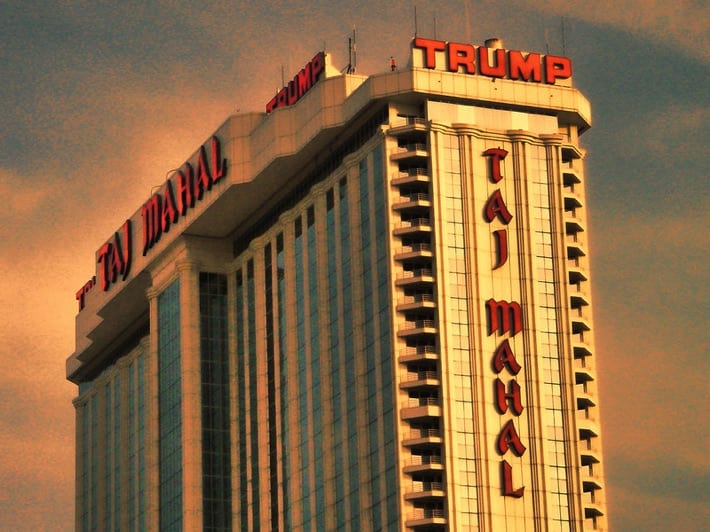
Let’s look at the actual casinos themselves, then. They were the apple of Donald Trump’s eye when he first opened them, using his reputation as a flashy businessman to open casinos that reflected his personality. Glitz and glamour were the order of the day, with many in Atlantic City hoping that they would revitalise the place’s failing fortunes.
For many, the manner in which Atlantic City was left desolate when the Trump casino empire collapsed was a graphic representation of ‘Donald Trump’s business model and his way of doing things’. He has always adopted a ‘zero-sum, winner-take-all philosophy’, which played out in real-time when it came to the world of casinos.
Donald Trump first started looking for properties to turn into casinos in the early part of the 1980s, gaining a licence to operate casinos from the New Jersey Casino Control Commission on the 15th of March, 1982. He intended to build his own casino but was side-tracked when asked by the Chief Executive Officer of Holiday Inn and Harrah’s to oversee the Holiday Inn Casino-Hotel’s construction.
The property opened its doors in May of 1984 and, in 1986, Trump bought out the Holiday Inn’s shares and re-named it, turning it into the Trump Plaza Hotel and Casino. Trump Hotels & Casino Resorts was underway, though the company wouldn’t take on that name until 1995 when Donald Trump officially created it.
Trump Plaza Hotel and Casino
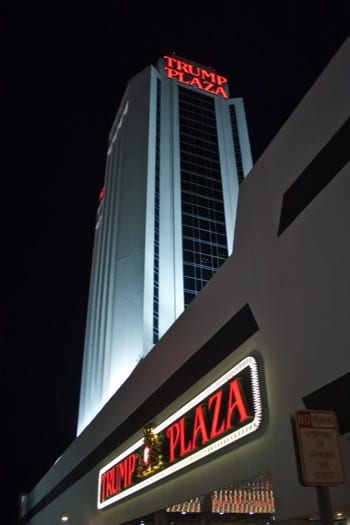
The building of what would become Trump Plaza Hotel and Casino was started in June of 1982, with Harrah’s coming on board a month later and initially changing the direction of things. Donald Trump oversaw construction and then Harrah’s operated the actual property, which opened as Harrah’s at Trump Plaza on the 14th of May, 1984.
It offered more than six hundred rooms, seven restaurants, a showroom with seven hundred and fifty seats, a health club and a casino that was spread over sixty thousand square feet. It stood next to Caesars Atlantic City and, within five months, it changed its name simply to Trump Plaza. This was in part because of a fear over the clientele it would attract.
Harrah’s Marina, which existed elsewhere on the boardwalk, was known for being a low-stakes casino, but Donald Trump had added 85 high-roller suites to the hotel and they were barely being used. A disagreement between Trump and the Holiday Inn board ensued, which eventually led to the property mogul buying them out for $70 million in 1986.
Ironically, it was Trump’s own property that saw Trump Plaza’s fortunes decline, when people began to favour the newly opened Trump Taj Mahal at the start of the 1990s. Indeed, it only just avoided missing a default payment in 1991 and it was only able to do so by taking out a $25 million mortgage on its own parking garage.
When Trump formed Trump Hotels & Casino Resorts in 1995 he also granted it ownership of Trump Plaza. The site opened an East Tower in two phases over 1995 and 1996, with Trump World’s Fair then opening in May of 1996, which was connected to Trump Plaza by a loggia. Still the business struggled, however.
In May of 2011, an announcement from Trump Entertainment Resorts confirmed that a decision would be made to either sell or renovate the casino. A proposed sale to the Meruelo Group for $20 million fell through, however, so the casino closed its doors on the 16th of September, 2014. That left around 1,300 people out of work.
It was soon scheduled for demolition, but this had to be delayed twice. Eventually the deed to the land was bought by Carl Icahn, the former senior leader of the Trump Plaza mortgage. He terminated the complex lease agreement that was in place on the land in December of 2018, meaning that Donald Trump’s association with it was completely over.
Trump Marina
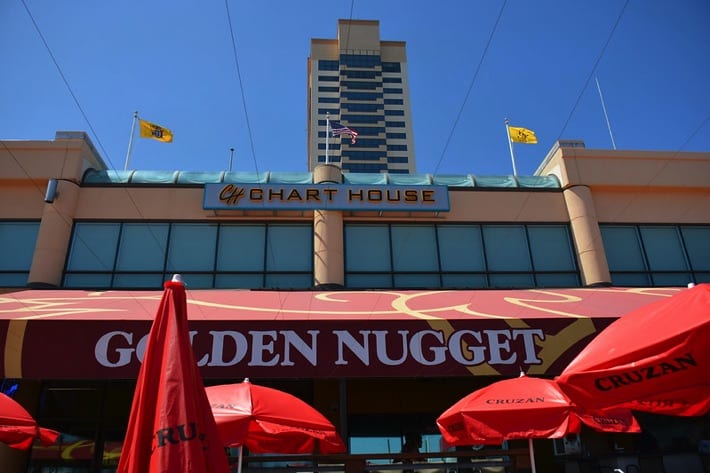
The building that housed Trump Marina was originally built by Hilton Hotels, but the company was denied a gambling licence before it was completed and Donald Trump swooped in to buy it from them. It opened its doors in 1985 as Trump Castle, becoming the setting for the TV Show version of Yahtzee and, later, a game show entitled Trump Card.
As with Trump Plaza, revenues took a bit of a nosedive in the wake of Trump Taj Mahal opening, combined with the broader economic factors brought on by the Gulf War and the recession. Trump’s father, Fred, had to buy casino chips for $3.5 million in order to allow the company to make a bondholder payment, with the casino later paying a $30,000 fine for this ‘illegal loan’.
Eventually, the matter was settled by giving bondholders 50% ownership of the casino, which Trump bought back in 1993. He sold it to Trump Hotels & Casino Resorts for $130 million in stock, as well as $355 million in assumed debt in 1996. Attempts to sell a share in the property fell through, so in June of 1997, it was renamed as Trump Marina.
More attempts to sell were later looked into, including a deal for Coastal Development to buy it for $316 million and turn it into a Margaritaville casino. This also fell through eventually, though bondholders, who had taken over Trump Entertainment Resorts when it had been declared bankrupt in 2009, were still eager to sell.
Nowadays the building is still standing, but it is now a Golden Nugget. This is thanks to the purchase of the building by Landry’s in 2011 at a price of $38 million. It has been renovated since then, re-opening in 2012. Since then, the Golden Nugget has launched an online casino, which is the most profitable in New Jersey.
Trump World’s Fair
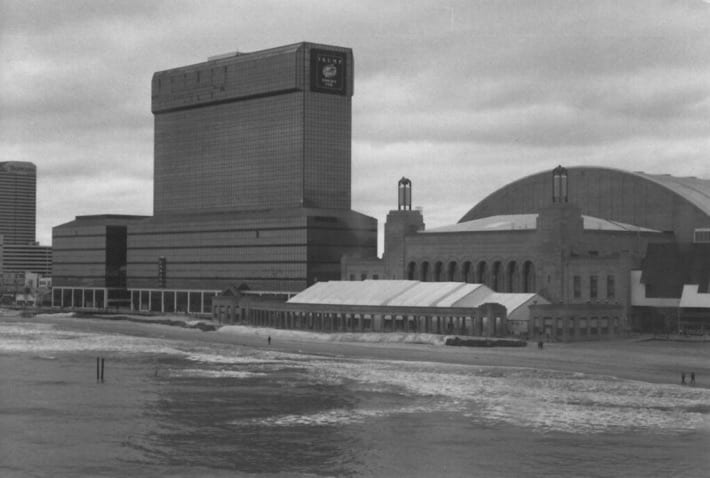
Thought the site that would eventually become Trump World’s Fair opened in 1981, it didn’t actually become a Trump property until 1989. It began life as part of Playboy Enterprises, but in 1984 the complex became Atlantis. It was split over either side of Florida Avenue, with the casino, hotel tower and restaurants on one side and an eight hundred seat auditorium on the other.
It filed for bankruptcy in 1985 and then struggled on until 1989, at which point it was denied a gaming licence renewal. It was bought by Donald Trump in June of 1989 for $63 million and retitled as the Trump Regency. Ownership of it was transferred to the mortgage holder, Chemical Bank, in 1992, with Trump buying it back off them for $60 million in 1995.
When it re-opened in May of 1996 it did so as Trump World’s Fair at Trump Plaza Hotel and Casino, with the two venues being linked together courtesy of a loggia. The success of it was short-lived, however, and problems, such as pool that leaked into the lower levels, plagued it. It was permanently closed in October of 1999 and then torn down in 2000.
Trump Taj Mahal
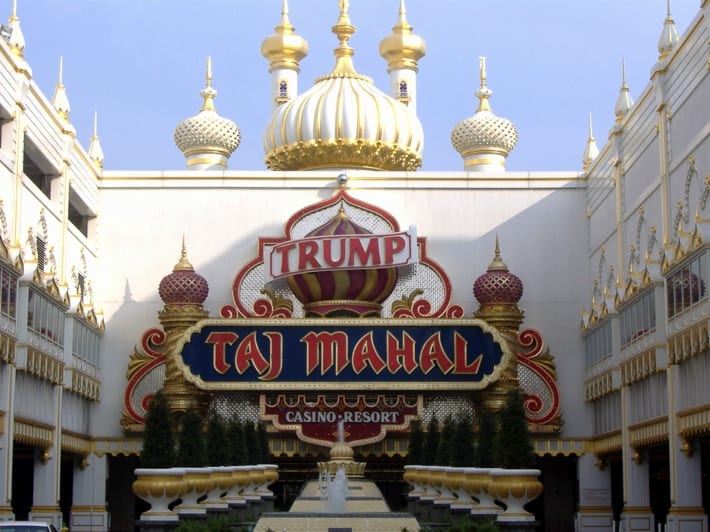
Was the Trump Taj Mahal too successful for its own good? It’s difficult to tell, but we do know that when it opened in April of 1990 it was popular enough to mean that it took business away from Trump’s other casinos in Atlantic City. Ground was broken on the building of the casino in 1983 when Resorts International, who also owned the neighbouring Resorts Casino Hotel, began construction.
James Crosby, the head of Resorts International, died in 1986 before it was complete and his heirs doubted their ability to complete it. Several companies and developers made bids to take it over, but Donald Trump won a controlling stake in 1987 with a bid of $79 million. He was made the head of Resorts International and planned to open the casino within a year.
The construction of the hotel underwent further issues, however, including being caught up in a takeover battle between Donald Trump and the television produced Merv Griffin. A settlement wasn’t reached until November 1988, with Griffin purchasing Resorts International and Trump getting the Tag Mahal casino at a cost of $273 million.
The casino eventually opened its doors on the second of April 1990, having ultimately cost nearly one billion dollars to complete. It offered 120,000 square feet of casino floor, claiming to be the biggest in the world. In just a year, the casino was put through a prepackaged bankruptcy, with Trump having to give 50% of the business to bondholders.
It was purchased by Trump Hotels & Casino Resorts in 1996, having spent much of the 1990s being watched by federal investigators who considered it to be the preferred gambling destination of New York Russian mobsters. The Chairman Tower was opened in 2008, meaning that the complex offered more than two thousand rooms.
2013 saw the Taj Mahal open the first ‘Casino Strip Club’ in America, with scantily clad dancers operating in the venue. In 2016, a strike by workers meant that the casino lost all of its dealers as well as other staff members, with the casino eventually being shut down. Hard Rock International confirmed its purchase of the property in March 2017.
Trump 29 Casino
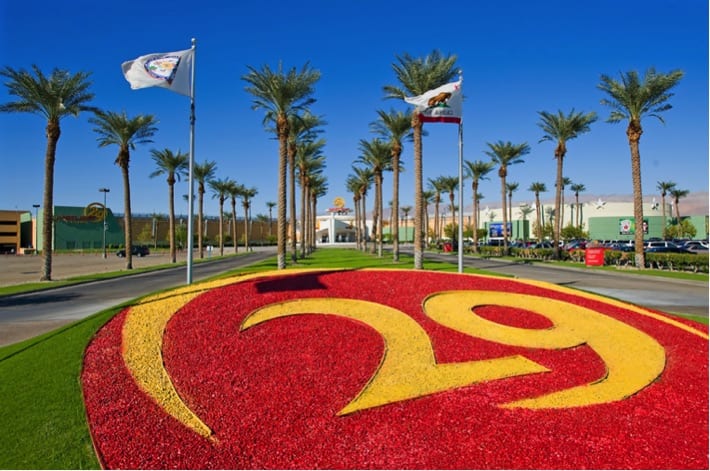
On the 14th of January, 1995, the Spotlight 29 casino opened in Coachella, California. It was a Native American casino, which opened under the National Indian Gaming Regulatory Act of 1988. In March of 2001, the Twenty-Nine Palms Band of Mission Indians, who had opened the casino, agreed to team up with Donald Trump, with the casino becoming Trump 29 Casino.
Perhaps somewhat unsurprisingly given what had happened with Trump’s other casinos, the relationship between him and the Native American tribe didn’t last long. Having opened in its re-branded state in April of 2002, the partnership ended in 2006 and the casino returned to its original name. It is still open today as Spotlight 29 Casino.
Trump as a Failed Businessman
Though the forty-fifth President of the United States of America might like to portray himself as a constantly successful businessman, an image that was furthered by his presence on the TV show The Apprentice, the reality appears to be in stark contrast. Even when he took to Twitter to dismiss reports of his business failures that had appeared in The New YorkTimes, he didn’t actual argue with the facts.
Though Trump dismissed it as ‘Fake News’, saying that everyone suffered debts in the 1990s because of the recession, the figures show something different. Business was generally good for Americans in the 1980s, yet Trump’s hotels and casinos managed to lose $359.1 million between 1985 and 1989. When the economy weakened at the start of the 1990s, he added a further $517.5 million to that loss.